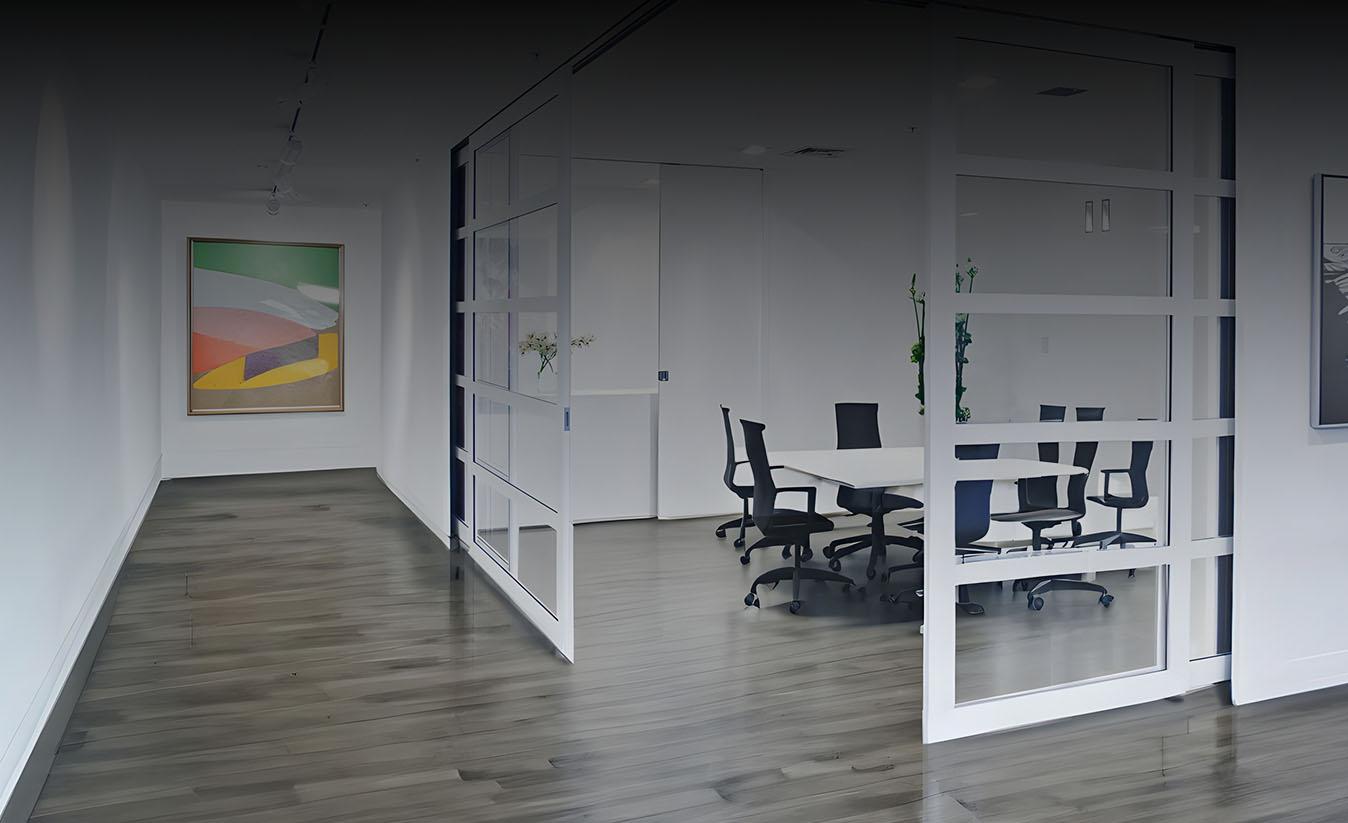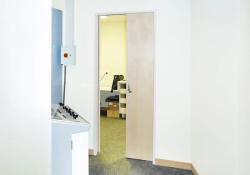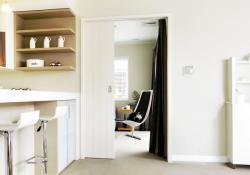Thank you!
Your submission has been sent.

The term ‘cavity slider’ refers to the pocket frame, including the track and running gear, installed within the wall framing
Cavity sliders are all about efficiency, creating space, and improving functionality. Do you have cavity slider questions? Just ask the cavity slider experts! Here are some answers to frequently asked sliding and cavity sliding door questions.
The term ‘cavity slider refers to the pocket frame, including the track and running gear, installed within the wall framing. The door slides out of the way into the pocket in the wall, creating a solution that leaves clear space on both sides of the wall and the opening, encouraging cohesion between spaces.
A cavity slider is comprised of three separate parts that can be ordered together or separately depending on requirements: The cavity slider (the pocket); the door; and the handle.
Cavity sliding doors are a practical solution for those areas where there is not enough space for a pre-hung door, traditionally used in smaller rooms such as bathrooms, wardrobes and pantries. Cavity sliding doors provide an alternative to a traditional swing door wherever space is of concern. Hinged doors require space for both the door itself as well as the entire path of its rotation, while cavity sliding doors require only a fraction of the space, simply sliding into the wall.
Cavity sliders can be an accessible doorway solution - easier for disabled users and those with reduced mobility to operate and navigate than swinging alternatives in domestic environments. Cavity sliding doors can be used in numerous different applications throughout the entire house, including bedrooms, bathrooms, laundry, and walk-in wardrobes, as well as between living spaces.
Choosing the right cavity slider for your project may be more important than you think! The most common complaints about cavity slider doors are due to inferior quality products or issues with installation. It is important to choose a high-quality product that will last - remember, the frame ends up inside your wall! Whether you’re looking for a discreet door that disappears quietly into the background or are looking to make a bold statement with a feature opening, cavity sliders provide a solution for doorways throughout a project.
A cavity sliding door can be the same style as the hinged doors in your home. A wide range of options are possible, including moulded panels or grooved patterns, or specialty timbers. It is recommended that doors with steel inserts are used for cavity sliders to provide more stability and reduce the likelihood of the door bowing. Standard door sizes in Australia are 2040mm high and available in a range of widths, including 620, 720, 770, 820, 870 and 920mm. CS Cavity Sliders are designed to work with standard 38mm thick doors.
For a larger cavity slider, consider aluminium sliding doors, which can be manufactured to much larger sizes without the problems that timber doors have such as bowing or warping. A range of high-quality aluminium and glazed doors are available to suit cavity sliders.
A cavity sliding door can be the same style as the hinged doors in your Door handles are the ‘bling’ on your door. Choose a sliding door handle that has been specifically designed for cavity sliders. Typically, a cavity slider door can be fitted with recessed pulls, flush pulls, round handles, lever handles or hook pulls.
The exact door handle configurations may vary based on the specific product model, but include passage, privacy, and even key locking. A wide variety of finishes for door hardware are available to suit your decor and building codes.
The hardware used to operate a cavity slider includes a track system that is installed within the top of the opening and a set of rollers that are mounted to the top of the door leaf. The rollers glide along the track to slide the door leaf into the pocket or to bring it out into the opening for closing.
Cavity sliders are typically used in areas where space is at a premium or where a seamless transition between spaces is desired, such as between a kitchen and a dining room or a bedroom and a bathroom. The sliding door can be made of various materials, such as solid wood, glass or composite materials, and can be customised to match the interior design of the space
Installing a cavity sliding door is simple. CS Cavity Sliders arrive on site pre-assembled, ready for installation into the trimmed-out opening in the wall. The system can be made to measure to fit a wide range of door sizes. A wide range of finishing options available, making it a versatile option for any project.
You can customise the look of your doorway by selecting a door and hardware that match the aesthetic of your project. Doors can be timber, glass, aluminium or a modern contemporary design including a combination of materials. The style of door you choose for your cavity slider is limited only by your imagination. If you go for a timber door, choose one with steel inserts for more stability and less likelihood of the door bowing. Large doors can act as a design feature as well as an opening for dividing large rooms or partitioning spaces such as a living and dining area or living and kitchen spaces.
The advantages of cavity sliding doors are not limited to commercial and residential applications. Improved accessibility and reduced safety hazards are also valuable considerations within the healthcare sector. The ability to eliminate “dead” space is also incredibly useful within hospitality, such as in hotels, where tight spatial constraints are already standard practice, but where hinged doors are still seen as the accepted solution to the separation of rooms.
Door size or trim size: Standard internal doors in Australia are 2040mm high and either 620, 720, 770, 820, 870 and 920mm wide. Cavity sliders can be manufactured to custom sizes to match a non-standard measurement such as the trim size (hole in the wall) if required.
Jambs: flat for fitting architraves over the top or grooved for wall linings, usually supplied pine as standard, but custom options are available
Wall framing and lining thickness, e.g. 90/10 or 70/10.
Extra features: e.g. soft close, automation, ply panels, H3 components
Door type/glass type
Handle style (e.g. CaviLock CL400 Magnetic, Handle function (e.g. Key Locking), Handle Finish (e.g. Satin Chrome or Matt Black)
With its sleek design and space-saving capabilities, the CS Cavity Slider is an excellent choice for any residential or commercial project. CS Cavity Sliders are available in many sizes and finishes, and can be configured to suit the specific needs of your project. If you are looking for a high-quality sliding door system, CS Cavity Sliders are a complete solution.
Have more cavity slider questions?
Contact our team of cavity slider experts for more information.

Cavity Slider Solutions
Specialised cavity solutions for bracing walls, tiled walls, x-ray barriers, wet areas, handicap accessibility, acoustic and sound dampening, glass doors, and more.

CL400 Magnetic Range
The CL400® Magnetic cavity slider handle, with its patented magnetic catch and plunger system, offers a secure ‘hold close’ and smooth locking, available in five standard finishes.

Standard Cavity Sliders
Choosing the right cavity slider for your project is more crucial than you might think! It's important to select a high-quality product that will stand the test of time since the frame will be hidden inside your wall.
What is a Cavity Slider?
Thank you!
Your submission has been sent.